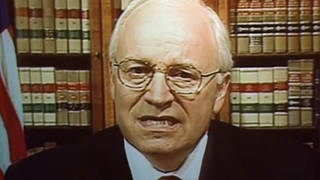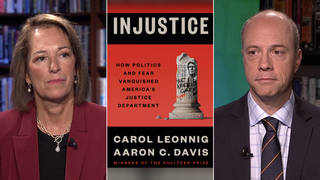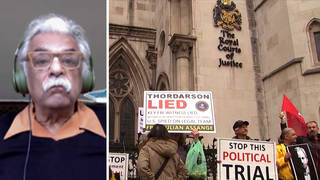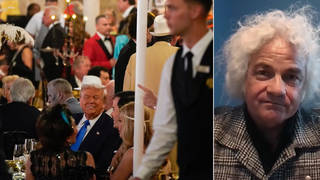
Guests
- Robert GibbsWhite House news conference July 26, 2010.
- Julian Assangefounder of WikiLeaks speaking at a news conference in London on July 26, 2010.
The disclosure of a massive trove of classified military records documenting the Afghanistan war has ignited a firestorm and increased pressure on the White House to defend its military strategy. We play highlights of the White House press conference in Washington and Julian Assange’s press conference in London. [includes rush transcript]
Transcript
AMY GOODMAN: The disclosure of a massive trove of classified military records documenting the Afghan war has ignited a firestorm and increased pressure on the White House to defend its military strategy. In the biggest leak in US history, more than 90,000 internal records of US military actions in Afghanistan over the past six years was published by the whistleblower website WikiLeaks on Sunday. The documents provide a devastating portrait of the war in Afghanistan, revealing how coalition forces have killed hundreds of civilians in unreported incidents, how a secret black ops special forces unit hunts down targets for assassination or detention without trial, how Taliban attacks have soared, and how Pakistan is fueling the insurgency.
In Congress, House leaders are rushing to hold a vote on a critical war-financing bill as early as today, fearing that the disclosures could stoke opposition to the measure. Meanwhile, tensions between the US, Afghanistan and Pakistan appear further strained in the wake of the leak.
The leak dominated Monday’s White House press briefing. Press Secretary Robert Gibbs described the leak as a, quote, “potential national security concern” and “very real and potential threat.”
PRESS SECRETARY ROBERT GIBBS: Look, I think our reaction to this type of material, a breach of federal law, is always the same, and that is whenever you have the potential for names and for operations and for programs to be out there in the public domain, that it, besides being against the law, has a potential to be very harmful to those that are in our military, those that are cooperating with our military, and those that are working to keep us safe.
AMY GOODMAN: Gibbs repeatedly emphasized the material in the leaked documents is not new.
PRESS SECRETARY ROBERT GIBBS: Again, I think it’s — let’s be clear, and I want to make sure that I’m clear on this. Based on the fact that there’s nothing — there’s no broad new revelations in this, our concern isn’t that people might know that we’re concerned about safe havens in Pakistan or that we’re concerned, as we are, about civilian casualties. Lord, all you need is a laptop and a mouse to figure that out, or fifty cents or a dollar-fifty depending on which newspaper you buy. I don’t think that is — that is, in a sense, top secret. But what generally governs the classification of these documents are names, operations, personnel, people that are cooperating, all of which, if it’s compromised, has a compromising effect on our security.
AMY GOODMAN: White House Press Secretary Robert Gibbs rejected the conclusion that the documents call the Obama administration’s war in Afghanistan into question. Instead, he underscored that the leaked documents are from 2004 to 2009 and do not relate to the current phase of the war.
PRESS SECRETARY ROBERT GIBBS: Let’s understand this, when you talk about the way the war is going in Afghanistan. The documents purportedly cover from January — I think January 2004 to December 2009. I can’t speak for the conduct of that war from an operational perspective for most of that time. I do know that when the President came into office in 2009, he, in the first few months, ordered an increase in the number of our troops; having spent two years talking about how our efforts in Afghanistan were greatly under-resourced, increased resources in troops to provide security for an election; and then, as you well know, conducted a fairly comprehensive and painstaking review of our policy, which resulted in December 1st, 2009’s speech about a new direction in Afghanistan.
AMY GOODMAN: That was White House Press Secretary Robert Gibbs.
Well, Wikileaks founder Julian Assange also gave a news conference yesterday at the Frontline Club in London. He discussed the significance of the leak, what the documents contain, and said they contain evidence of possible war crimes that must urgently be investigated. Here are some of the highlights.
JULIAN ASSANGE: What we see is that the US Army is an enormous boat that is extremely hard to turn around, and the cover-up of those sorts of crimes begins at the bottom and moves its way to the top. So, it is quite hard to enact a new policy and have it filtered down to a change in practice. A new policy by Obama does not mean a change of practice by the US military anymore than a new policy by McChrystal meant a change in practice by US forces.
It is up to a court to decide, clearly, whether something is, in the end, a crime. That said, prima facie, there does appear to be evidence of war crimes in this material. An example is the Task Force 373 HIMARS missile strike on a house which killed seven children.
This is the equivalent of opening the Stasi archives. No one particular Stasi file has a tremendous impact to change a whole nation, to change the whole nation of Germany, but across all the Stasi files, many individuals are represented, and many people in German society could see their connection to the behavior of the Stasi. And that’s something that came out over time. So I expect that to be the case also in this material. It is the — it is a history. It is an enormous compendium of material that will affect many different people in different ways. We, as a journalistic group, the four media groups who worked on this, have really only just scratched the surface. So I think between us, we’ve probably read about a thousand or 2,000 of these reports properly. So it’s going to take the rest of the world press and academics to look at the statistics that come out of this and the soldiers and returned soldiers from Afghanistan, from coalition forces. It’ll take the Taliban to look at this, the refugees from Afghanistan, the locals still living there, to all look at this and say, “I understand that event. I was there. This is just a tiny summary. Let me tell you what really went on. That was my father. He was killed. That was my buddy who was killed. That was my commanding officer who gave me an order that I was extremely uncomfortable with.” Or we would like to see this material, the revelations that this material gives, be taken seriously, investigated by governments and new policies put in place as a result, if not prosecutions of those people who have committed abuses.
It’s important to understand, this material doesn’t just reveal abuses. This material describes the past six years of war, every major attack that resulted in someone being detained or someone being killed. That tells you how the war is going, where this happened, in what different parts of Afghanistan, what sort of weapon systems were used, which particular military units. Is there a killer — is there a killer unit in the United States military? Because there’s been histories of that. You can find out using this data. You can create a simple computer program. We haven’t done it yet, but any one of your technical staff can create a simple computer program to add up the kills by unit and get — and find a top kill unit. So that’s an example of something that can be immediately extracted from this.
So you can really see how the war in Afghanistan is going and then compare that to government statements and government policy. This is the raw material that ends up on the big boards on the war room. There’s even a field in there, DColor, which describes the color that this material ends up when it’s displayed on the big boards. This is the raw ingredients that lead to Pentagon statistics about civilian casualties, that lead to graphs about how many insurgents are killed. We only ever normally see those figures in aggregate, but now we have all the events that are used to create those figures, and we can understand whether those aggregate figures are in fact accurate or are they distortions. In fact, we can see, in many cases where we know what’s in this database and we have press sourcing or Afghan government investigation, we can see the disparity between these two. So we can see, in fact, the aggregate figures are based on faulty data.
AMY GOODMAN: WikiLeaks founder Julian Assange, highlights from his press conference yesterday in London at the Frontline Club. He was standing in front of a photograph of a soldier in Vietnam.
This is Democracy Now!, democracynow.org, the War and Peace Report. When we come back from break, we’ll be speaking with the investigations editor of The Guardian newspaper in London. Stay with us.












Media Options